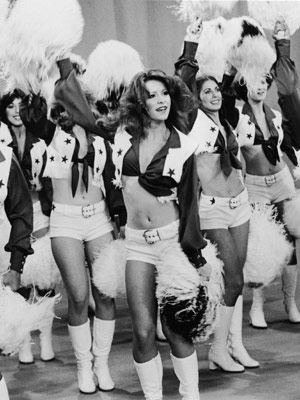In the decade that the term “hooters” was coined, the 1970s, the Dallas Cowboy Cheerleaders plunged into the modern breast era, donning outfits with necklines that just a few years earlier might have gotten a go-go club shuttered. GM Tex Schramm had been gradually trimming the former “Cowbelles” cheer-squad suits, but in 1972 the women really busted out. Coach Tom Landry, a computer geek and Jesus freak, was not pleased. From The Last Cowboy by Mark Ribowsky, via the excellent Delancey Place:
“The vibe in Thousand Oaks at summer camp in 1967 contained a strange brew of old and new currents. The Cowboys’ first winning season had taken the team so far that it accumulated almost mythical properties in Dallas and the exigency for a grander scope. Clint Murchison Jr. relocated the Cowboys’ offices again, now to the Expressway Tower, an opulent fifteen-story glass structure at 6116 North Central Expressway that Murchison built on property he had bought expressly for the purpose. He put the organization on the eleventh floor, its picture windows offering sweeping vistas of the city. He also rented out a ground-floor space to the Playboy Club, which catered to the same upscale, male-dominated crowd that Murchison hosted in the Cowboy Club at the Cotton Bowl during home games. Not for a minute did Murchison consider that his coach might be embarrassed to have as neighbors cleavage-displaying young women wearing bunny ears and cottontails. The Cowboys were the hippest party in town, and the juxtaposition fit. Neither did he mind if players repaired to the Playboy Club after a hard few hours at the practice facility, which was under a big bubble behind the building. Landry already had the squares’ allegiance; could it hurt if they were balanced by Hugh Hefner’s ideal of 1960s American manhood?
Tex Schramm, for one, saw no downside to that equation. Working from the same idea, he junked the Cowbelles that off-season and created a new cheerleading squad, one that would remind no one of high school girls in hoop skirts and sweaters. Instead, the Cowgirls were professional go-go dancers hired to shake their pompoms while wearing hot pants and tight vests, showing off ample racks and bare midriffs. When Landry learned of it, he nearly had cardiac arrest. Years later in his memoirs, he was still exercised, saying that while the Cowgirls ‘transformed sideline entertainment,’ and that it was an example of Schramm’s lust to foster ‘a high profile image of style, flair, and maximum visibility,’ it also ‘sexually exploited the young women by pandering to the baser instincts of men.”
Tags: Tex Schramm, Tom Landry

